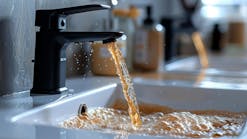The Water Quality Assn.’s Guidelines for Disinfection and Sanitization of Water Treatment Equipment recommend that equipment be disinfected every six months, when it is serviced, after installation and when there is a contamination issue with the source water. If water treatment equipment is not properly sanitized, bacteria can grow and multiply on the inside surfaces of tanks and hoses.
A reverse osmosis (RO) unit will capture the microorganisms in the filters. As the unit sits idle, those organisms spread to the hard surfaces in the unit, causing foul odor and taste, color issues and even the spread of disease.
Water softeners are also susceptible to microorganisms. They can be introduced through improper service techniques or contamination from mainline boil water advisories or water wells. When contaminated water is brought into the system, it runs through the resin. As the system sits idle, the microorganisms spread, causing odor, taste and clarity issues.
According to the U.S. Environmental Protection Agency (EPA), in 2010 there were more than 700 boil water advisories per day and more than 1,000 contamination reports. That means there were more than 1,000 opportunities for contaminated water to introduce microorganisms to equipment, affecting areas as large as 500 customers at a time.
EPA defines the process of disinfection as killing 99.99% of the microbial population, and sanitization as killing 99.9%. There are several products available to disinfect water treatment equipment.
Chlorine
Chlorine (calcium hypochlorite) is effective against a variety of microorganisms. The typical strength is 5.25% and it is readily available for purchase. Chlorine is also a strong oxidizer, which is why it stains, reacts with iron and can be harmful to resin and membranes. Liquid chlorine gases off over time. This process is accelerated by high temperatures, resulting in problems when calculating proper dosage. Its recommended strength is 50 ppm with a contact time of two minutes.
Hydrogen Peroxide
Hydrogen peroxide can typically be found in 3%, 7% and 35% strengths. With its double oxygen atoms, it is a powerful oxidant that will react with organic substances. It also will oxidize trace amounts of minerals in the equipment during the sanitization process. Iron in particular can cause problems when it is oxidized. The recommended strength is 30,000 ppm with a contact time of three hours.
Iodine
Iodine is a fairly inexpensive sanitizer, but it stains surfaces over time. The recommended strength is 12.5 ppm with a contact time of 15 minutes.
Chlorine Tablets
Sodium chlorite tablets also can be used to sanitize. The directions state that it takes 10 minutes for the final solution to become active, and that the solution will remain active for seven days. The recommended strength is 200 ppm with a contact time of 10 minutes.
Liquid Sanitizers
Sani-System is the only sanitizer on the market that is both EPA- and NSF-approved for use in water treatment equipment. It comes in exact doses for water softeners and RO units. These are poured directly into the unit and take 60 seconds to disinfect it. One drawback of this product is that overdoses cause bubbles and a soapy aftertaste. Sani-System’s recommended strength is 200 ppm with a contact time of 60 seconds.
Download: Here


